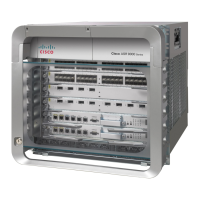Network Synchronization Support
Synchronization Status Message and Ethernet Synchronization Messaging Channel
5
Cisco ASR 1000 Series Aggregation Services Routers Software Configuration Guide
Synchronization Status Message and Ethernet Synchronization
Messaging Channel
Network clocking uses the following mechanisms to exchange the quality level of the clock between the
network elements:
• Synchronization Status Message, page 5
• Ethernet Synchronization Messaging Channel, page 5
Synchronization Status Message
Network elements use Synchronization Status Messages (SSM) to inform the neighboring elements
about the Quality Level (QL) of the clock. The non-ethernet interfaces such as optical interfaces and T1
or E1 SPA frames, use SSM. The key benefits of the SSMs are:
• Prevents timing loops.
• Provides fast recovery when a part of the network fails.
• Ensures that a node get timing from the most reliable clock source.
Ethernet Synchronization Messaging Channel
In order to maintain a logical communication channel in synchronous network connections, Ethernet
relies on a channel called the Ethernet Synchronization Messaging Channel (ESMC), which is based on
the IEEE 802.3 Organization-Specific Slow Protocol (OSSP) standards. ESMC relays the SSM code that
represents the quality level of the Ethernet Equipment Clock (EEC) in a physical layer.
The ESMC packets are received only for the port
s configured as clock sources, and transmitted on all
the SyncE interfaces in the system. These packets are then processed by the clock selection algorithm
on route processors (RP) and are used to select the best clock. The Tx frame is generated based on the
QL value of the selected clock source, and sent to all the enabled SyncE ports.
Clock Selection Algorithm
The clock selection algorithm selects the best available synchronization source from the nominated
sources. This algorithm exhibits nonrevertive behavior among the clock sources with the same QL value,
and always selects the signal with the best QL value. For clock option 1, the default is revertive, and for
clock option 2, the default is nonrevertive.
The clock selection process work
s in the following modes:
• QL-Enabled Mode, page 6
• QL-Disabled Mode, page 6
When multiple selection processes are present in a netw
ork element, all the processes work in the same
mode.

